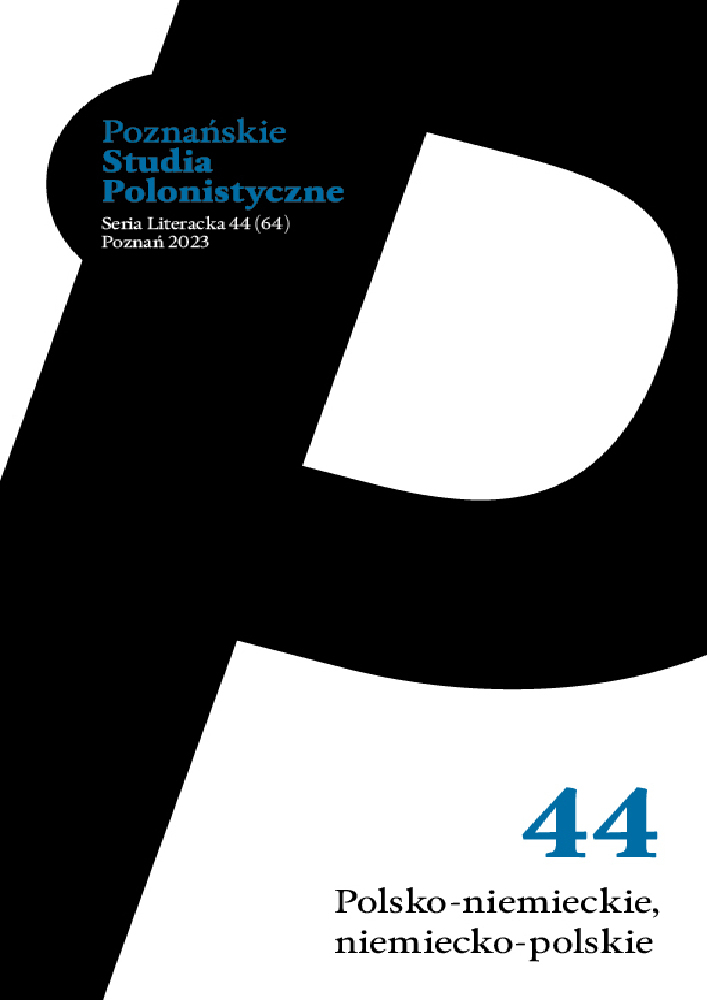Abstrakt
The article is devoted to the first three volumes of Michael Meinert’s Hochwald-Saga (The High Forest Saga) series, whose action takes place in Silesia in the 19th century; these are are: Gescheiterte Flucht (Failed Escape), Der zerrissene Graf (Lost count) and Ehrlicher Schwindler (Honest swindler). In these works, the author breaks away from the stereotypical perception of Silesia as a space of memory, the critical turning point of which was the end of World War II. He does not create images of a “lost homeland” – Silesia becomes an attractive historical space for him precisely because of its past character, and is a fascinating setting for novels with historical plots. At the same time, he revives the history of Silesia as a province of the Kingdom of Prussia and later of the German Empire. He also creates images of space, assigning them additional meanings, which is in line with the idea of space semantisation promoted by Yuri Lotman. An extremely important element in the composition of Meinert’s works is the creation of Silesia as a sacred space in which existential, axiological and theological questions are asked. In his understanding, places become a humanised space which has its own characteristic identity and often depicts the emotional states or character traits of the novel’s figures; moreover, it plays an important role in shaping their attitudes and values. The purpose of this text is to analyse the poetics of Meinert’s above-mentioned novels with particular emphasis on the topos of Silesia, its characteristics, and the role and functions it plays in them. As it is closely related to the poetics of place, attention is also paid to selected aspects of geopoetics in the sense proposed by Elżbieta Rybicka.
Bibliografia
Genette Gérard (1998), Die Erzählung, przeł. A. Knop, Wilhelm Fink, Monachium.
Genette Gérard (2001), Paratexte. Das Buch vom Beiwerk des Buches, przeł. D. Hornig, Suhrkamp, Berlin.
Jasińska-Wojtkowska Maria, Dybciak Krzysztof, red. (1993), Proza polska w kręgu religijnych inspiracji, KUL, Lublin.
Łotman Jurij (1984), Struktura tekstu artystycznego, przeł. Anna Tanalska, PIW, Warszawa.
Meinert Michael (2012), Gescheiterte Flucht, BOAS, Burbach.
Meinert Michael (2014), Der zerrissene Graf, BOAS, Burbach.
Meinert Michael (2015), Ehrlicher Schwindler, BOAS, Burbach.
Meinert Michael (2018), Interview mit Michael Meinert, rozm. przepr. Nicole Katharina Timm, https://tinyurl.com/bddknht8 [dostęp: 25 maja 2022].
Meinert Michael (2022), Herzlich willkommen, http://www.michael-meinert.eu/ [dostęp: 9 maja 2022].
Papuzińska Joanna, Leszczyński Grzegorz, red. (1998), Dzieciństwo i sacrum. Studia i szkice literackie, Stowarzyszenie Przyjaciół Książki dla Młodych – Polska Sekcja IBBY, Warszawa.
Papuzińska Joanna, Leszczyński Grzegorz, red. (2000), Dzieciństwo i sacrum 2. Studia i szkice literackie, Stowarzyszenie Przyjaciół Książki dla Młodych – Polska Sekcja IBBY, Warszawa.
Rybicka Elżbieta (2014), Geopoetyka. Związki literatury i środowiska, Universitas, Kraków.
Skotnicka Gertruda (2000), O „Lecie leśnych ludzi” Marii Rodziewiczówny, w: Dzieciństwo i sacrum 2. Studia i szkice literackie, red. Joanna Papuzińska, Grzegorz Leszczyński, Stowarzyszenie Przyjaciół Książki dla Młodych – Polska Sekcja IBBY, Warszawa, s. 13–30.
Tarnowski Janusz (1998), Spotkanie dziecka ze światem sacrum, w: Dzieciństwo i sacrum. Studia i szkice literackie, red. Joanna Papuzińska, Grzegorz Leszczyński, Stowarzyszenie Przyjaciół Książki dla Młodych – Polska Sekcja IBBY, Warszawa, s. 17–24.
Wójcicka Edyta (2020), Przestrzeń literacka jako nośnik wartości w perspektywie edukacyjnej na przykładzie powieści J.R.R. Tolkiena „Hobbit, czyli tam i z powrotem”, „Studia Edukacyjne”, nr 59, s. 285–310,
Licencja
Prawa autorskie (c) 2023 Marta Ratajczak

Utwór dostępny jest na licencji Creative Commons Uznanie autorstwa – Bez utworów zależnych 4.0 Międzynarodowe.
Autorzy
Autorzy tekstów przyjętych do publikacji w czasopiśmie „Poznańskie Studia Polonistyczne. Seria Literacka” są zobowiązani do wypełnienia, podpisania i odesłania na adres redakcji umowy o udzielenie nieodpłatnej licencji do utworów, z zobowiązaniem do udzielania sublicencji CC.
Zgodnie z umową, autorzy tekstów opublikowanych w czasopiśmie „Poznańskie Studia Polonistyczne. Seria Literacka” udzielają Uniwersytetowi im. Adama Mickiewicza w Poznaniu niewyłącznej i nieodpłatnej licencji oraz zezwalają na użycie sublicencji Creative Commons Attribution-NoDerivatives 4.0 International (CC BY-ND 4.0).
Autorzy zachowują prawa do dalszego, swobodnego rozporządzania utworem.
Użytkownicy
Zainteresowani użytkownicy internetu uprawnieni są do korzystania z utworów opublikowanych od 2016 roku w „Poznańskich Studiach Polonistycznych. Serii Literackiej” pod następującymi warunkami:
- uznanie autorstwa – obowiązek podania wraz z rozpowszechnionym utworem, informacji, o autorstwie, tytule, źródle (odnośniki do oryginalnego utworu, DOI) oraz samej licencji;
- bez tworzenia utworów zależnych – utwór musi być zachowany w oryginalnej postaci, nie można bez zgody twórcy rozpowszechniać np. tłumaczeń, opracowań.
Do wszystkich tekstów opublikowanych przed 2016 r. prawa autorskie są zastrzeżone.
Inne
Uniwersytet im. Adama Mickiewicza w Poznaniu zachowuje prawo do czasopisma jako całości (układ, forma graficzna, tytuł, projekt okładki, logo itp.).

